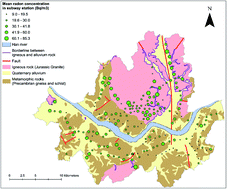Spatial modeling for radon concentrations in subway stations in Seoul, Korea
Abstract
This study examined the environmental and geological determinants of radon concentration in subway stations by applying a spatial statistical model to the integrated GIS database. The data were collected for 237 underground subway stations located inside the city of Seoul, South Korea and used for mapping to illustrate the spatial distribution of airborne radon exposure and analysis of potential contribution of station-specific and geological determinants. A Bayesian conditional autoregressive regression (CAR) model was developed to explain the radon concentrations, and the predicted radon surface was generated and visualized to identify hotspot regions where elevated radon exposure is likely to be present in underground settings. The findings include: (1) subway stations located within granite bedrock maintained relatively higher radon concentrations; (2) underground radon emanation is not only controlled by lithology and the associated uranium content of the rocks and soil, but also by structural factors which facilitate easy migration of radon from deeper parts of the earth's crust; (3) radon risks would be elevated if the underground facility is constructed too deep without any control measure; and (4) not only the foundation of an underground facility but also the nature of the soil and rocks in the vicinity helps determine whether or not dangerous levels of radon gas are likely to accumulate inside. This modeling effort is expected to provide guidelines regarding the identification of future station locations with a lower radon risk and the mandatory installation of adequate radon reduction systems for the underground space where people stay or commute for long periods of time.



 Please wait while we load your content...
Please wait while we load your content...